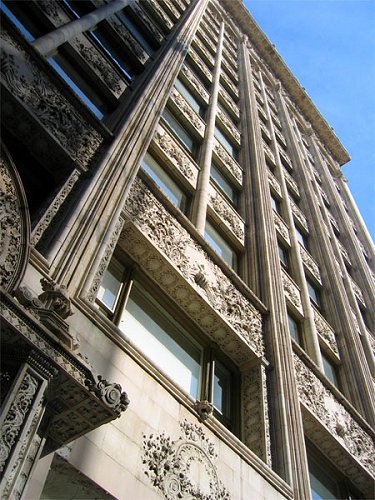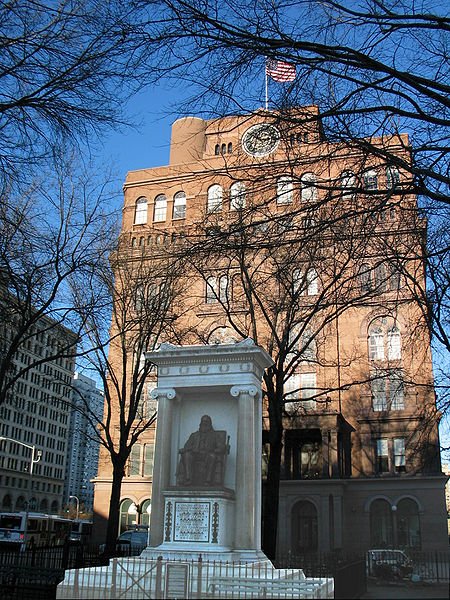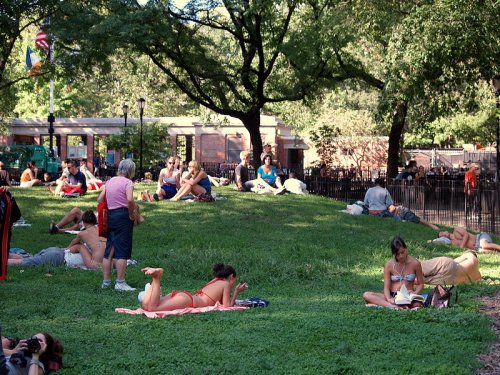East Village NYC
Contents
- East Village NYC
- Places to Visit in the East Village
East Village, as its name suggests, is on the east side of Manhattan, across from Greenwich Village. This was where Peter Stuyvesant, the Dutch Director-General of the colony that was to become New Yorck, had his country estate here.
Once occupied by the rich, the area became the residence of poorer immigrants in the early part of the 20th century, with the Irish, Germans, Jews, Poles, Ukrainians and Puerto Ricans, all coming to stay here and leaving their mark in the neighborhood, noticeable from their churches to their restaurants. In the later part of the 20th century, hippies make it their home.
The neighborhood today has a vibrant nightlife, with music clubs and theaters. An area of East Village known as Alphabet City – because the avenues carry letters of the alphabet – has become one of the trendiest areas in New York City.
Places to Visit in the East Village
The center of the East Village is located at St. Marks Place and Bowery Street, creating a cross-cultural intersection of the past and the future. This area of the East Village has the reputation of being the hipster mecca of Manhattan, attracting mainly suburban teenagers and free-spirited tourists. Here you’ll find plenty of great alternative shops specializing in everything from vintage tees and records to new age electronics and skateboards. The East Village is also known throughout the Big Apple as offering an amazing nightlife scene, so be sure to pack your dancing shoes in the back of that New York City car rental! Killer clubs are located throughout the East Village so don’t even think about turning in early! Tompkins Square Park is another great spot to check out in your New York City car rental as it boasts a rich history of political activism and protests. Refurbished basketball courts and playgrounds can be found throughout the park, making this East Village attraction perfect for all ages.
Alphabet City
Alphabet City (see map) is a neighborhood within the East Village of Manhattan, New York City. It is called Alphabet City because the avenues there are named after single letters such as A, B, C, and D.
Alphabet City is bordered by Houston Street to the south and 14th Street to the north. Among the landmarks here include Tompkins Square Park and the Nuyorican Poets Cafe.
As in the case with many of the neighborhoods in Manhattan – and for that matter, New York City – Alphabet City has seen a succession of ethnic groups coming to make it their home. In the 1840s and 1850s, the area has inhabited mostly by a German-speaking community, and was popularly called “Kleindeutschland” or “Little Germany”.
By the 1880s, the Germans were leaving Kleindeutschland, and in their place came other immigrants such as Eastern European Jews, Irish, and Italians. The living condition at that time was bad.
Bayard-Condict Building
Bayard-Condict Building, at 65 Bleecker Street, is a beautiful 1898 building in East Village, Manhattan, New York City. It is the only structure designed by the great Chicago architect Louis Sullivan, who was the mentor to Frank Lloyd Wright. Sullivan was extolled as the Father of Modernism and the creator of modern skyscrapers, yet he died in poverty.

In designing the Bayard-Condict Building, Sullivan is said to have had a difference of opinion with Silas Alden Condict, the building’s owner over the sentimental angels in the cornice. Eventually Condict got his way.
Today the Bayard-Condict Building stands as a memorial of the great architect, who, due to financial problems and alcohol, died poor, and even had his funeral paid for by his former understudy but now wealthy Wright.
The best way to view the Bayard-Condict Building is from afar. Move back a bit and you get a better view of the building.
How to reach the Bayard-Condict Building
Take the 6 train to the Bleecker Street subway station. Walk west down Bleecker Street and you’d see the Bayard-Condict Building on the right side of the road. You can get a better view of it by walking south down Crosby Street.
Colonnade Row
Colonnade Row is a row of four townhouses at 428-434 Lafayette Street, in the East Village of Manhattan, New York City. They are part of what was originally nine such houses built in the Greek Revival style.
The Colonnade Row was built by a developed named Seth Geer in 1833. Critics called it “Geer’s Folly” because they thought nobody would want to live so far east. They were mistaken, of course, when very famous and rich people such as John Jacob Astor and Cornelius Vanderbilt became owners of the houses. Washington Irving, who wrote Rip Van Winkle, also lived there for a while, as did famous English author Charles Dickens.
Five of the houses on Colonnade Row were demolished in the early 20th century when the John Wanamaker Department Store pulled them down to make way for a garage. The remaining houses are also presently in a state of ruin.
How to reach the Colonnade Row
Take the 6 train to Astor Place subway station. You emerge from the subway near Starbucks Coffee (as of Feb 2010). Cross the street at Astor Place and head south on Lafayette Street. You will see Colonnade Row on your right.
Cooper Union
Cooper Union, or in full The Cooper Union for the Advancement of Science and Art, is a privately-funded college in Manhattan, New York City. It is located at 7 East 7th Street, in the East Village.

Cooper Union was founded in 1859 by Peter Cooper, the 19th century industrialist and inventor, who is also one of the richest man in America in his time. Although he came from a poor background and had only one year of schooling, Cooper went on to design and build the first steam locomotive in the United States. His businesses included everything from steel to iron, real estate to insurance, railroads, telegraphy and even glue. Cooper also invented instant gelatin, and with the help of his wife created what would eventually become known today as Jell-O.
For all his successes, Peter Cooper’s ultimate dream is to give talented young people the opportunity that evaded him, which was to provide good tertiary education and make it as “free as air and water”. To this effect, he founded The Cooper Union, a college that provide free classes to the deserving.
The six-storey college building was the first building to be built with rolled-iron I-beams which again, was invented and produced by Cooper. The building was inscribed as a National Historic Landmark in 1961.
Today, 150 years after the founding of his college, Cooper Union continues to be one of the few American institutions to offer full-tuition scholarship to the students that it admits. The scholarship is worth US$130,000 as of 2008. It makes Cooper Union one of the most selective colleges in the United States. The possibility of gaining entry to Cooper Union’s school or art and architecture is just 5%, meaning there’s a 95% chance of rejection.
To learn more about Cooper Union, you can visit their website at www.cooper.edu.
How to reach Cooper Union
Take train 6 to Astor Place subway station. Walk east on Astor Place and you will reach Cooper Union, the red building on your right at Cooper Square.
Grace Church
Grace Church is an Episcopal church of the diocese of New York. It is located along Broadway, near the New York University, in the East Village, Manhattan.
Grace Church was designed by James Renwick Jr, the famous architect of St. Patrick’s Cathedral, when he was only 23 years old. The church, in the Gothic Revival style, is considered by many to be Renwick’s masterpiece and finest achievement.
The cornerstone of Grace Church was laid in 1843. The church was consecrated in 1846, the same year that Trinity Church was consecrated.
The grandest occasion at Grace Church in the 19th century was most probably the wedding of the famous dwarf Charles Sherwood Stratton, better known as General Tom Thumb, from P.T. Barnum’s circus, to Lavinia Warren, another dwarf.
How to reach Grace Church
Take the R ow W trains to the 8th Street/NYU subway station. Walk north on Broadway. At the intersection with E 10 Street, you can see Grace Church on the right side of Broadway.
Merchant’s House Museum
The Merchant’s House Museum is a charming museum in the East Village, Manhattan, New York City. It is located at 29 E 4th Street, in a townhouse built in the Greek Revival style.
The Merchant’s House Museum offers a fascinating glimpse into the way of life in the 19th century. It was built in 1832. The name Merchant’s House refers to its owner, Seabury Tredwell, a wealthy merchant who acquired it in 1835. The house remained in the Tredwell family for close to one hundred years, until the last member of the family, Gertrude Tredwell, passed away in 1933.
In 1936, the house was opened to the public as a museum. Its grandness and the opulence of its fixtures tells us about the lifestyle of the rich in the 19th century.
Today the Merchant’s House Museum is open to the public from 12:00 noon to 5:00 pm from Thursdays to Sundays. The museum is closed on Tuesdays and Wednesdays. The admission fee is now $10 per adult visitor, $5 per student and seniors, and free admission for children aged 12 and below.
How to reach the Merchant’s House Museum
Take 6 train to Astor Place subway station. Walk south on Lafayette Street until intersection with East 4th Street. Turn left and walk east on East 4th Street until you reach the Merchant’s House Museum on your left. At the time I wrote this (Feb 2010), the house appears to be standing next to an empty lot.
Public Theater
The Public Theater is a large red brick building at 425 Lafayette Street, in the East Village, Manhattan, New York City.
When it was built in 1849, the Public Theater building housed the Astor Library, a library founded by John Jacob Astor and built by his son William B. Astor of the Waldorf=Astoria fame.
The Astor Library later merged with the Tilden and Lenox collections and became the New York Public Library. The building was designed by Alexander Saeltzer, a German-born architect, in the Rungbogenstil style which was in fashion back in Germany at that time.
In 1965, the building was under the threat of demolition. Joseph Papp, the founder of the New York Shakespeare Festival, persuaded the city to buy up the building and make it the home of the Shakespeare company. This was achieved, and library had a makeover that turned it into a six-theater facility. Today known as the Public Theater, it was the original home of such musicals as Hair and A Chorus Line, which became a long-running Broadway show.
How to reach the Public Theater
Take the 6 train to Astor Place subway station. Walk south on Lafayette Street and you will reach the Public Theater, a dark-red building, on your left.
St Mark’s Church-in-the-Bowery
St Mark’s Church-in-the-Bowery is an Episcopal church in the East Village, Manhattan, New York City. Built in 1799, it is already quite an old church. Yet it stands on the ground of an even older place of Christian worship.
There has been a church standing on the site of St Mark’s Church as early as 1660. It belonged to Peter Stuyvesant, the Dutch Governor of New Amsterdam (as New York was called in its founding days). Peter Stuyvesant, or to be more accurate, Petrus Stuyvesant (he was never known as Peter in historical documents), is credited as one of those who established New York.
Stuyvesant bought the land in 1651 to use as a bowery – a sort of farm among the Dutch settlers. He built a family chapel there in 1660. Stuyvesant passed away in 1678, and was interred in the vault of the chapel.
In 1793, the great-grandson of Peter Stuyvesant, also named Petrus, donated the chapel to the Episcopal Church, and stipulated that a new church be built on the ground. That new church was to become the St Mark’s Church.
St Mark’s Church-in-the-Bowery has a cemetery which is the final resting place of many famous New Yorkers including Alexander Turney Stewart, a wealthy merchant whose concepts of retail and distribution were useful to stores such as Sears, K-Mart and Wal-Mart.
The Bowery
The Bowery (see map) refers to a street and its surrounding neighborhood in Manhattan. The area known as the Bowery is bounded by East 4th Street and the East Village to the north, Canal Street and Chinatown to the south, Allen Street and the Lower East Side to the east and Bowery (the street) and Little Italy to the west. The street called the Bowery was previously known as Bowery Lane before 1807. The name refers to the bouwerij, or farm, owned by Peter Stuyvesant, the last Dutch Governor-General of New Netherland, in the area. Today the Bowery runs from Chatham Square in the south to Cooper Square in the north. Along the way, it is intersected by Canal Street, Delancey Street, Houston Street, and Bleecker Street. At the intersection of the Bowery and Delancey Street is the Bowery Subway Station.
An impoverished area in the 1920s and 30s, the Bowery area has seen rapid gentrification in the last decade of the 20th century. New high-rise condominiums were being built in the area such as Avalon Bowery Place while upscale retailers such as Whole Foods Market also moved in.
Tompkins Square
Tompkins Square is a park in East Village, Manhattan, New York City.
This peaceful-looking park was the site of the first organized labor demonstration in America that took place in 1874. If years following, it continued to be the venue for shows of discontent, including the hippie movement of the 1960’s and the riots that erupted over police eviction of homeless people.

Within the park is a monument depicting a boy and a girl looking at a steamboat. It commemorates the General Slocum steamboat disaster in 1904 which claimed one thousand lives.
How to reach Tompkins Square
Take the L train to the First Avenue subway station. Walk south on First Avenue until intersection of E 10th Street. Turn left and walk east down E 10th Street until you arrive at Tompkins Square Park on your right.
Shopping in the East Village
If you’re looking to score some one of a kind gear look no further than the bohemian themed shops of the East Village. One of the top shopping strips in all of NYC lies between Second Avenue and Avenue A on East 9th Street. Here you’ll find a diverse array of smart boutiques showcasing up and coming designers like Selia Yang and Jill Anderson. St. Marks Place is where to go if you’re looking to get a little funky, while Astor Place remains a mature favorite.
The East Village is a neighborhood unlike any other in Manhattan so don’t miss out on your chance to visit the area that gave helped give birth to a variety of great movements including the Beat Generation, Experimental Theater, Punk Rock, Organized Activism, and the Melting Pot. The East Village is a place to speak your mind and enjoy your freedom as an American, so go ahead and reserve your New York City car rental today!
Lower East Side of Manhattan
One of the newest hot spots in New York City is that of the East Village, located in what used to be considered the Lower East Side of Manhattan. Bounded by 14th Street and Houston Street, the East Village was originally a part of Greenwich Village, up until the 1980s when real estate developers began promoting the new moniker. Today the East Village is home to a variety of different social and cultural groups, creating a colorful array of local residents and business owners.
The East Village has also become one of the trendiest New York neighborhoods, especially in the real estate sector, so expect to see plenty of shiny new apartment complexes jumbled in between the older brownstones. The East Village is a charming place to visit in your New York City car rental thanks to countless shops, attractions, and plenty of great coffee shops! So if you’re looking to enjoy an afternoon of window shopping and sightseeing, look no further than the charming community of the East Village the next time you’re out and about in your New York City car rental!
The East Village (and Alphabet City beyond) used to be off the tourist radar but since the ‘80s the area has been substantially cleaned up. It is now a twenty-something paradise, with bars on every corner and tons of cheap food options, from pizza to falafel to Japanese. Take a walk down St. Marks for what is left of punk New York or visit the numerous Japanese restaurants on East 9th Street. Head further east and you will wind up at Tompkins Square Park, a large park between Avenues A and B.
Getting Around the East Village
If you’re planning on taking a leisurely drive throughout the East Village you may wish to purchase a local street map. Roadway names in the East Village tend to be a bit strange compared to other Manhattan neighborhoods, so plan ahead and keep a map handy in the glove compartment of your New York City car rental. An example of this strange naming sensation is that of Alphabet City. This neighborhood inside the East Village consists of lettered streets, causing extreme confusion to out-of-town drivers.

